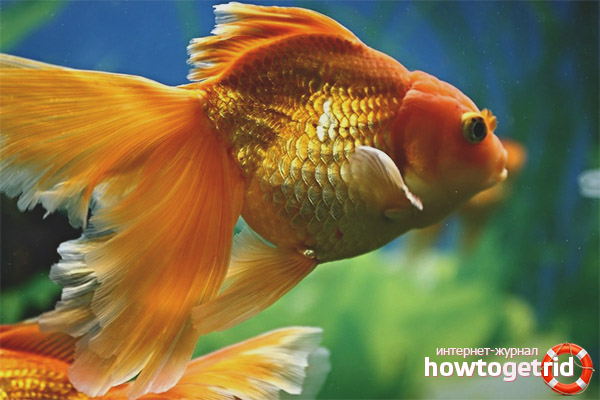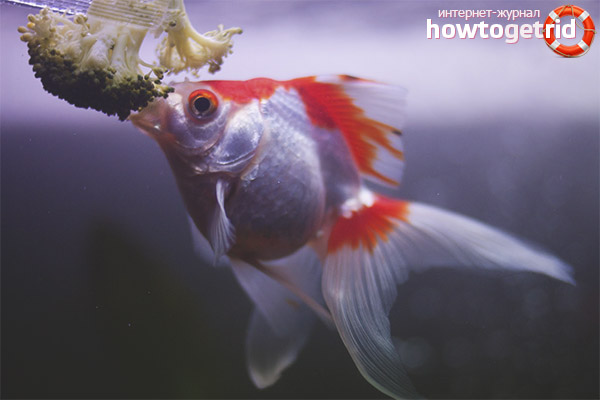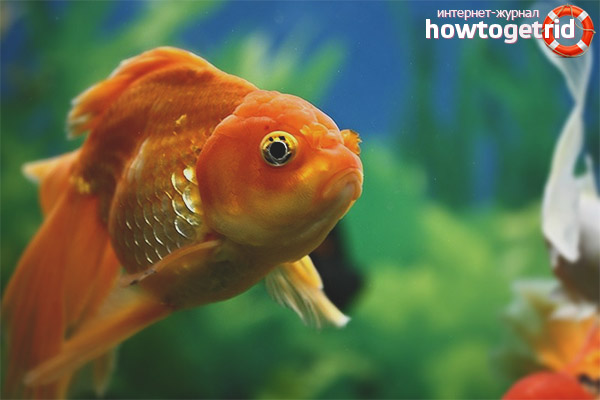The content of the article
Veiltail is a popular and quite popular variety of goldfish. Beginning aquarists who want to try themselves in this field, do not ignore such beauty. But experienced people know that before acquiring it is necessary to study all the features of aquatic inhabitants. Today's material is dedicated to everyone who has no idea how to keep the veil-tail.
Description
- Inhabitants designed to be kept in a domestic tank are not found in the natural environment. However, these fish became derivatives of crucian carp, which can be found everywhere. Due to the fact that the veiltail came from strong fish, it is unpretentious in maintenance, can and wants to exist in cool water, and also normally tolerates various changes in its environment.
- The peculiarity of this variety is that the fish can overeat, as they say, to death. She completely lacks a sense of proportion, the veiltail quickly becomes oily and goes astray. Therefore, it is necessary to strictly dose the amount of food that these fish are given.
- The country of origin of the represented family is considered Japan. However, over time, it has become very widespread and has gained universal recognition.
- There are many varieties on this day, each aquarist is trying to create his own unique type. Despite the changes in color, the format of the case remains unchanged. All the same veiled tail, downed torso, interesting fins.
- The case is shortish, square format. Thanks to this, the fish are different from their other relatives. But the tail is considered a feature of these inhabitants, it is laid out like a veil, due to which the family received this name.
- Due to the structural features of the body of the fish can not be called excellent swimmers. They do not keep pace with other neighbors, and also seem to sway while swimming. The tail is divided into 2 sections, spreads down. More aggressive roommates bite him off to put the fish in a dysfunctional state.
- If you create all the conditions for the fish, they will delight the owner for a very long time. These pets are included in the category of long-livers, exist for more than 10 years, reach 18–20 cm in height. Regarding shade, veil tails are quite diverse. But the most popular are individuals with a red or golden tint, which stand out from the rest of the inhabitants of the reservoir.
- In order to touch upon the difference between a female and a male, it is necessary to study the main aspects. Firstly, until puberty is reached, it is simply impossible to do. Secondly, sometimes male and female individuals look identical. But, as a rule, males are smaller, females rounder and larger. In order to confidently identify gender, experts recommend waiting for spawning. Then the male representative on the gills form whitish bulges.
Feeding
- It is worth immediately clarifying that feeding has its own nuances. We mentioned earlier that fish overeat and die from gluttony. Therefore, all food is strictly dosed, it is impossible to overfeed in any case.
- This family has no stomach, the whole meal immediately passes into the intestinal tract. Therefore, fish will eat exactly as much as there is food in the tank.
- The main difficulty in feeding is that these individuals need to correctly calculate the portion size. It is recommended to give food twice a day in such an amount that the fish ate it in 1 minute.
- You need to choose food created specifically for goldfish. In stores you will find premium products, so there will be no difficulties with this.Choose a granular composition, it is most suitable.
Content
- The family under discussion is unpretentious in terms of care, can quickly adapt to the conditions of the aquatic environment and at the same time feels comfortable. It is allowed to plant in a round tank, but this is undesirable.
- It is worth remembering that if you put fish in such an aquarium, and also deprive vegetation and various snags, foliage, soil, then the fish will lose their vision, it will quickly die.
- It is possible, but not recommended, to keep fish in a round aquarium. They grow up to 20 cm, so choose a home based on dimensions. About 100 liters are allocated per individual. water. With each person added, 60 liters are added. space.
- An external filter is simply necessary, the fish leave a lot of waste. Also, a third of the fluid is removed weekly, a new one is added instead.
- Regarding temperature, keep the water at 22 degrees. Even if the indicators fall to 10, it is not scary for the fish. No heater needed.
- Coarse or sand gravel is perfect as soil. It is worth noting that the individuals in question prefer to poke around in the ground quite often. At the same time, the fish often swallow rather large particles. Because of this, they die.
- Water parameters can vary greatly. The best indicators are ph from 6 to 8, and dGH from 5 to 19.
Compatibility
- The fish in question has a fairly peaceful temperament. For this reason, they get along well with most individuals. The only problem is that veil tails need a cool environment. In addition, they without hesitation eat fry and small individuals.
- The presented individuals get along well with related species. Among those, it is necessary to distinguish the Shubunkins and telescopes. But even in this case, you should always make sure that the veil-tails have time to fully eat. Sometimes they do not succeed just because more nimble neighbors live with them.
- For the same reason, it is not recommended to keep guppies with these individuals. If you nevertheless decided to keep veil-tails in the general aquarium, you should not hook small fish to them. Also avoid specimens that often break fins. Among these, tetragonopterus, thorns, and various types of barbs can be distinguished.
Breeding
- Provide the individuals in question with a reasonably spacious aquarium. Be sure to monitor the freshness and purity of water. It is recommended to contain a small amount of small-leaved algae in the container. Breeders recommend keeping spawning in direct sunlight for several hours a day.
- If possible, leave spawning in direct sunlight, until the offspring. Sexually mature individuals begin to arrange mating games with the onset of spring. During this period, the males tirelessly chase the females. At this time, heterosexual individuals are recommended to be planted for at least a week.
- Fish should provide a plentiful and high-quality diet. Give preference to live food. Otherwise, males can eat eggs during spawning. One female should have up to 3 males. Gradually raise the temperature in the breeding ground by several degrees. Wait for caviar throwing.
It is worth remembering forever that members of the family love not too warm water. They perfectly live in cool springs, which is not always known to a beginner.
Video: veil tail












Submit